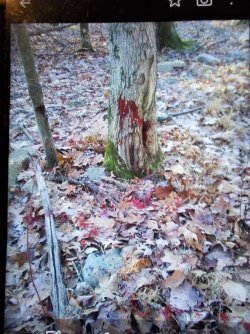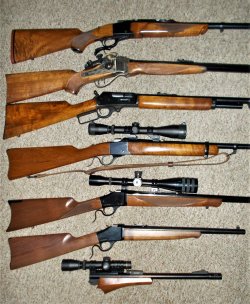Hy all .
Got me an Winchester Model 1886 in 45/70 ,and i plan to load it with barnes bullets 300 grain . Can somebody help me to find an accurate load for it . f( if possible with vithavouri powder because we not get the most of american powders anymore ,. ) i have no experience in loading cases like 45/ 70
thank you all very much
I did not read all the posts, so this may be a duplicate. In a 45-70, faster does NOT kill better, all it does is kick the crap out of the shooter. 1500 FPS is way more than enough speed to get the job done. Millions of Bison died from 45-70 and 50 cal projectiles going 1,100 fps.
The effect of speed on incapacitation is typically called Hydrostatic shock. That effect does not happen with projectiles travelling less than 2500 FPS. It is why Roy Weatherby built the beast of cartridge that is the 460 Weatherby Magnum. I owned one in a left hand action MKV. It produces awesome recoil, it is the only rifle I owned that has a brake on it. Despite all the roaring, flame and drama it does not kill any faster than my 45-70 and I have shot a lot of bears with both. I have also shot bears with a 45-70 loaded from1100 FPS to 2000. I can tell you from experience the sweat spot is 1400-1500 fps for quick kills, reasonably flat trajectory, at least by 45-70 standards, and quick second shot recovery. I have shot 45-70 out of everything from Trap Doors, 1186 Winchester, Marlin to Ruger #1s. In all of them, except the Trap Door that I loaded to 1,100 fps, my favourite load is a Hornady 350 grain RN over 3031 powder at 1500 fps. Substitute the correct powder available to you for this speed.
If you drive a 405 to 500 grain bullet at 1500 FPS it will go clear through a Bison. Making them go faster will NOT improve the results, it just beats the snot out of the shooter.
I have posted this on other 45-70 threads and it matches my experience as well.
This is by Randy Garret of Garret Ammunition Manufacturers.
https://www.garrettcartridges.com/penetration.html
The following article is based on bullet penetration test results as measured in water-saturated penetration materials (wet newspapers). Water is the primary substance of life, and constitutes about 90% of the content of all mammals. I have observed that some "testers" have chosen wood boards or dry newspapers for penetration testing material, and this is a very poor choice, which in no way simulates the characteristics of a bullet impact with animal flesh. Wood tends to channel the bullet path, and is less demonstrative of the terminal instabilities inherent to non-expanding bullets when impacting game animals, and is thus an inferior material for the testing of bullet penetration characteristics. Water-saturated penetration materials such as newspapers or ballistic gelatin are far superior with regards to their ability to demonstrate the terminal instabilities that typically occur when non-expanding bullets impact live animal flesh. - Randy Garrett
There are few things in the world of ballistics less well understood than the issues relating to comparative penetration. It is commonly believed that the faster one drives a solid bullet, the deeper the penetration. We see this all the time in the various attempts, via new calibers, to achieve higher velocity for improved performance on heavy game. The current rage among big bore shooters seems to be the 458 Lott, since it achieves a good 200-300 fps higher velocity than the 458 Winchester Magnum. It is claimed that the new 458 Lott is an improvement over the 458 Winchester Magnum since its higher velocity supposedly results in more lethal impact-effect and deeper penetration. This, it is claimed, is just the ticket for busting the heaviest game. Of course, the new 458 Lott also achieves greater kinetic energy as a result of its higher velocity, and this is also a convincing characteristic for those brave souls in pursuit of the heaviest game.
Despite all the impressive "science" deployed to reinforce the assertion that higher speed projectiles are more capable of inflicting the deep penetration and impact-effect required to reliably anchor heavy game, one finds that these assertions simply do not withstand common sense, repeatable penetration testing. In fact, if one conducts these tests, one finds that there is nothing that can be observed which supports the assertion that the faster one drives non-expanding solids the deeper they penetrate.
Very interestingly, if one takes the Hornady 500-grain .458 diameter solid bullet and compares the penetration that results from impact speeds varying from about 1500-fps to 2500-fps, one finds that the higher impact speeds produce the least penetration. When driven to about 1500-fps (as the 45-70 will do) one finds that such solids produce nearly 6-feet of penetration in wet newspapers. When the same bullet is driven to about 2100-fps (as is characteristic of the 458 Winchester Magnum) one finds that the penetration is reduced to about 4 to 4 and 1/2 feet. When one tests the same bullet at 2300-2400 fps (as is characteristic of the 458 Lott) one finds that the penetration comes up nearly 20% short of that produced by the 458 Winchester. And when one tests the same bullet at the blistering speeds characteristic of the mighty 460 Weatherby Magnum, one finds that the penetration achieved is the most shallow produced by the various 458s.
What is apparent from testing is that penetration stops increasing at impact speeds above about 1250-1300 fps. When the impact speeds significantly surpass about 1600-fps, there is a very definite and measurable decrease in penetration depth. This raises some interesting issues regarding the relationship between kinetic energy generation and impact-effect. Although higher velocity projectiles always generate more kinetic energy they clearly do not produce deeper penetration, and when the velocities reach the levels common to today's magnums, the increases in velocity result in significantly reduced penetration. Simply stated, the faster they strike the faster they stop.
Fortunately for all of us who shoot the 45-70, it can be considered to be the deepest penetrating of the various 458 calibers. This is not due to any particular inherent superiority, but due to the 45-70's "inability" to achieve the velocity with heavy bullets that leads to decreases in penetration. The reasons why high impact speeds reduce penetration are not well understood. However, anyone who takes the time to run comparative penetration tests will find that those of us who pack a good 45-70 with heavy bullets need not take a back seat to any other 458 caliber, especially when the game is heavy and the penetration requirements are great.
- Randy Garrett



